Chevrolet K5 Blazer
The Chevrolet K5 Blazer is a full-size sport-utility vehicle that was built by General Motors. GM's smallest full-size SUV, it is part of the Chevrolet C/K truck family. Introduced to the Chevrolet line for the 1969 model year, the K5 Blazer was replaced for 1995 by the Chevrolet Tahoe. In 1970, GMC introduced its own model of the truck, called the Jimmy, which was discontinued in 1991 and replaced by the Yukon. The "Jimmy" name was chosen to reflect how GM may sound in a similar manner to how Jeep was thought to be a pronunciation of GP in the competing market. Both were short-wheelbase trucks and available with either rear- or four-wheel drive.
- See also Chevrolet Blazer (disambiguation)
| Chevrolet K5 Blazer | |
|---|---|
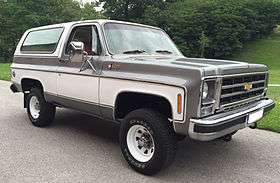 | |
| Overview | |
| Manufacturer | General Motors |
| Model years | 1969–1994 |
| Body and chassis | |
| Class | Full-size SUV |
| Body style | 2-door SUV |
| Layout | Front engine, rear-wheel drive / four-wheel drive |
| Chronology | |
| Successor | Chevrolet Tahoe GMC Yukon |
The K5 Blazer and Jimmy had "full convertible" removable tops until 1975. For 1976, GM introduced a half-cab design that was less prone to leaks and slightly safer in a roll-over. These half cabs had the convertible top begin a few inches behind the driver/passenger doors and run back to the tailgate.
The Blazer's long-wheelbase relative, with an integrated rear body and doors for 2nd row passengers, is the Chevrolet Suburban.
1969–1972
| First generation | |
|---|---|
 | |
| Overview | |
| Also called | GMC Jimmy |
| Model years | 1969–1972 |
| Powertrain | |
| Engine | 250 cu in (4.1 L) I6 292 cu in (4.8 L) I6 307 cu in (5.0 L) V8 350 cu in (5.7 L) V8 |
| Transmission | 3-speed TH-350 automatic 3-speed manual 4-speed manual |
| Dimensions | |
| Wheelbase | 104 in (2,642 mm) [1] |
| Length | 177.5 in (4,508 mm) [1] 180"(1971)[2] |
| Width | 79 in (2,007 mm) [1] |
.jpg)
The original K5 was a short wheelbase truck. It was available in 1969 model year as four-wheel drive only; for 1970, a two-wheel drive model was offered. There were four choices for power plants: the 250 straight-6, the 292 straight-6, the 307 V8, and the 350 V8.
The Blazer was designed and marketed to compete with International Harvester Scout and the Ford Bronco. Both of these were originally aimed at the short Jeep CJ series, which were much smaller than other trucks. The innovation of the Blazer was to simply offer a shortened pickup truck, which both increased interior space, and lowered the cost of production with a shared platform. The Blazer quickly became popular. For the first time, it married the off-road capabilities of the Scout with the "luxury" features like air conditioning and automatic transmissions routinely available on pickup trucks. By 1970, the Blazer was already outselling both of its older rivals. Ford, Dodge, and even Jeep would counter with similar shortened pickups, with the Dodge Ramcharger and Jeep Cherokee. It also came as a convertible.[3]
The two-wheel drive version came with independent front suspension and rear trailing arms, both with coil springs. The four-wheel drive version had a solid front axle and used leaf springs front and rear. Both versions used drum brakes at all four corners until 1971, when the entire GM light truck line got standard front discs. A tachometer was optional.[4]
There was also a choice between a three-speed automatic transmission Turbo Hydromatic (TH350), a three-speed manual transmission, and a four-speed Synchromesh (SM465) manual transmission, often referred to as the "granny gear" due to its 6.55:1 low first gear. Two transfer cases were offered: the Dana 20, available only with the manual transmissions, or the NP-205, available with both types of transmissions. The Blazer had 8 inches (200 mm) of ground clearance and an approach angle of 35°.[1]
In October 2019, a customized version of the first generation K5 Blazer was made using the entire body of a 2018 Chevrolet Tahoe was circulated throughout the social media world ahead of a scheduled display at the 2019 SEMA Show, and in honor of Blazer’s 50th anniversary.[5]
Engines:
- 250 in³ (4.1 L) I6 (1969–1984)
- 292 in³ (4.8 L) I6 (1970–1971)
- 307 in³ (5.0 L) V8 (1969–1973)
- 350 in³ (5.7 L) V8 (1969–1991)
Transfer cases:
- NP-205 - gear driven part-time four wheel drive
- Dana 20 - gear driven part-time four-wheel drive
Production Totals:
| Year | Production |
|---|---|
| 1969 | 4,935 |
| 1970 | 11,527 |
| 1971 | 17,220 |
| 1972 | 44,266 |
1973–1991
| Second generation | |
|---|---|
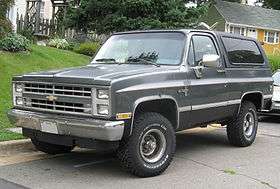 | |
| Overview | |
| Also called | GMC Jimmy |
| Model years | 1973–1991 |
| Powertrain | |
| Engine | 250 cu in (4.1 L) I6 292 cu in (4.8 L) I6 305 cu in (5.0 L) V8 307 cu in (5.0 L) V8 350 cu in (5.7 L) V8 400 cu in (6.6 L) V8 6.2 L Detroit Diesel V8 |
| Transmission | 4-speed SM465 manual 3-speed TH-350 automatic 3-speed TH-400 automatic 4-speed 700-R4 automatic |
| Dimensions | |
| Wheelbase | 106.5 in (2,705 mm) |
| Length | 184.8 in (4,694 mm)[6] |
| Width | 79.6 in (2,022 mm) |
| Height | 77.8 in (1,976 mm) |
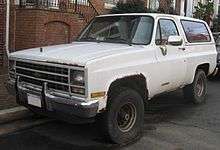


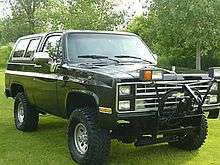
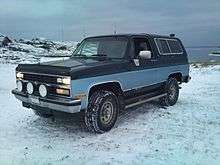
For 1973, GM's line of full-size trucks was redesigned and updated. A tilt-steering wheel became optional.[7] Although rear-wheel drive Blazers were manufactured until 1982, the majority sold were four-wheel drive.
Until 1975, the K5 had a removable convertible top. In 1976, a half-cab design was introduced and used until 1991.[8][9]
Although the GMT400 platform was introduced in the spring of 1987 as a 1988 model, the K5 Blazer, Suburban, and crew-cab trucks retained the earlier platform until 1991. For in late 1988 for 1989 models, the front grille was changed to resemble the squared-off ones used on the GMT400 series of pickups.
The K5 Blazer was fitted with a 250 cu in (4.1 L) inline-six as standard through 1984. Available engines included a 292 cu in (4.8 L) inline-six, small-block V8s of 305, 307, 350, or 400 cubic inches (5.0, 5.0, 5.7, and 6.6 liters), and a 6.2 L Detroit Diesel V8.
1973–1980 Blazers used the gear-driven part-time NP-205 transfer case (mostly mated to the SM465 manual transmission and some TH350s) or the chain-driven full-time NP-203 transfer case (mated to the TH350 automatic) and DANA-44 front/12-bolt rear axle combination through 1980. Starting in 1981 used the chain-driven NP208 transfer case (NP241 after 1988) with front 10-bolt/rear 10-bolt axle combinations until 1991. There is an overlap of 12-bolt rears into the early '80s, while the 10-bolt front axle was phased into production in the late 1970s.
The second generation K5 models incorporated the rear hatch glass and tailgate into a single unit, which allowed the glass panel to retract inside of the tailgate by use of a manual crank mounted on the tailgate or an electric motor activated by a key-operated switch on the tailgate and a dash-mounted switch. The weight of the large glass panel was rumored to be a liability as the manual crank gears wore prematurely and the electric motor was prone to frequent overheating and subsequent failure. This also included the electric motor drive cable which goes to the window regulator to the motor (similar in design to a speedometer cable), which usually would fail under heavy abuse. Another feature of the K5 Blazer tailgate was the safety switch connected to the electric motor which prevented the rear window from being raised if the tailgate was unlatched.
Since 1981 (in the wake of the 1973 Arab Oil Embargo and the 1979 energy crisis), Chevrolet and GMC used the smaller displacement 305s with a 9.2:1 compression ratio. These engines produced nearly as much torque as the 350, giving a similar driving feel. However, these power plants were underpowered and prone to detonation (engine knocking), especially with the electronic spark control module. To achieve the 9.2:1 compression ratio, the cylinder head chambers were smaller, measuring 56 cc instead of 76 cc.
Around 1976, a prototype K5 Blazer [10] was used as a testbed for a military CUCV vehicle built by Vic Hickey, father of the HUMVEE. Between 1983 and 1987, what is known as the M1009 CUCV was the production militarized version of the civilian K5. The differences are the lack of an air conditioner, an additional leaf spring in the suspension, a hybrid 12/24 V electrical system (described in detail below), blackout headlights, front mounted brush guard, a rifle rack, and special paint jobs. A majority of them are painted olive drab green or in the woodland camouflage pattern, though some vehicles that saw desert use were painted tan. All M1009s, including its derivatives, are powered with the 6.2 L Diesel power plant.
The M1009s have a split 24/12 V electrical system. Most of the truck actually runs on 12 V. It has two separate 12 V alternators and batteries wired in series, only the glow plug system, injection pump, the starter, and the jumper cable jack are wired to the 24 V terminals. everything else in the truck runs on 12 V. The glow plugs are actually 12 V glow plugs with a resistor pack on the firewall to drop the 24 V down to 12 V. This resistor pack can be bypassed and the glow plugs run directly off of the 12 V battery. If this is done and the 24 V starter is replaced with a standard 12v starter, the second alternator is no longer needed. (If this is done then the military 24 V slave adapter in the grille will need to be disconnected as well.)
Some decommissioned M1009s end up in law enforcement use (e.g. with the Los Angeles County Sheriff's Department) or sold through government auctions, but a handful are still in use by the National Guard.
After 1987, when throttle-body injection was introduced in the truck engines, the 350 was made the standard power plant.
GM temporarily changed the usual "C/K" designation to "R" and "V" for the 1987 through 1991 model years. This was done to avoid confusion with the GMT400-based Chevrolet C/K pickup trucks, which were introduced in 1988, during the overlap period.
In 1988, four new colors were introduced: Bright Blue Metallic, Forest Green Metallic, Light Mesa Brown Metallic, and Dark Mesa Brown Metallic. More new features for 1988 included a fixed mast antenna in place of the old windshield antenna, a trip odometer as part of the gauge package cluster, and an improved pulse windshield wiper control. Also, helping to reduce air leaks in the doors was a new door handle seal.
The 1989 Blazer had new base and up-level grilles, as well as new headlight bezels, body side moldings, and front bumper rub strips. Corporate 10-bolt axles were upgraded to 30 spline axle shafts from previous 28 spline. New for 1989 was the introduction of an all-new base coat/clear coat paint. The standard L05 5.7-liter V-8 now had one serpentine accessory drive belt in place of the older multi-belt accessory drive setup. 1989 was first year for the 241 transfer case and also the only year for speedometer cable driven version of the 241.
For the 1990 model year, all Blazers now had a standard rear wheel anti-lock braking system. A new electronic speedometer system, with a 6 digit odometer on the dashboard was also introduced for 1990, along with non-asbestos brake linings. A new brake warning light on the dashboard was also introduced for 1990. The Blazer body also used double sided, galvanized exterior sheet metal. A new option for 1990 was power mirrors. The 5.7 liter V8 (L05) engine was improved for 1990 with the addition of improved oil control rings, a redesigned rear crankshaft seal, a new camshaft sprocket design, non-asbestos intake manifold gaskets, and heavy-duty intake valves. 3 point shoulder harness also become standard for rear passengers. The rear seat arm rest were eliminated from rear seat to make room for shoulder belts and pads were added to the wheel housings.
For 1991, the 700R4 was renamed to the 4L60. The TBI (throttle body injection) system used on the Blazer's standard 5.7 liter V8 had longer throttle shaft bearings, new throttle return springs, and improved fuel mixture distribution. The 5.7 liter V8 also had new heavy-duty intake valves and powdered metal camshaft sprockets. Standard on all engines was a lighter more powerful 100-amp CS130 alternator. Two new exterior colors, Brilliant Blue and Slate Metallic were offered.
Engines:
| Engine | Years | Power | Torque | Notes |
|---|---|---|---|---|
| 250 cu in (4.1 L) I6 | 1973–1978 | 105 hp (78 kW) | 185 lb⋅ft (251 N⋅m) | |
| 1979–1984 | 130 hp (97 kW) | 210 lb⋅ft (285 N⋅m) | ||
| 292 cu in (4.8 L) I6 | 1973—1974 | |||
| 305 cu in (5.0 L) V8 | 1981–1986 | 160 hp (119 kW) | 235 lb⋅ft (319 N⋅m) | Federal emissions |
| 155 hp (116 kW) | 240 lb⋅ft (325 N⋅m) | California emissions | ||
| 1981 | 130 hp (97 kW) | 240 lb⋅ft (325 N⋅m) | 2-barrel carburetor | |
| 1987 | 170 hp (127 kW) | 260 lb⋅ft (353 N⋅m) | Throttle-body injection | |
| 307 cu in (5.0 L) V8 | 1973 | 130 hp (97 kW) | 220 lb⋅ft (298 N⋅m) | Federal emissions |
| 350 cu in (5.7 L) V8 | 1973–1986 | 160 hp (119 kW) | 275 lb⋅ft (373 N⋅m) | |
| 1981–1986 | 160 hp (119 kW) | 260 lb⋅ft (353 N⋅m) | ||
| 1987—1991 | 210 hp (157 kW) | 300 lb⋅ft (407 N⋅m) | Throttle-body injection | |
| 400 cu in (6.6 L) V8 | 1975–1980 | 185 hp (138 kW) | 300 lb⋅ft (407 N⋅m) | |
| 379 cu in (6.2 L) Detroit Diesel V8 | 1982–1991 | 135 hp (101 kW) | 240 lb⋅ft (325 N⋅m) |
(All power and torque figures are pulled from GM factory service manual)
Transfer Cases:
- Dana 20 - gear driven part-time four wheel drive (1973)
- NP-203 - chain driven full-time four wheel drive (1973–1979)
- NP-205 - gear driven part-time four wheel drive (1973–1980)
- NP-208 - chain driven part-time four wheel drive (1981–1988)
- NP-241 - chain driven part-time four wheel drive (1989–1991)
- (NP-208 & NP-241 are "shift-on-the-fly")
Axles:
- Dana 44 - Front axle (1973–1977/78)
- GM Corporate 10 Bolt - Front axle (1977/78–1991)
- GM Corporate 12 Bolt - Rear axle (1973–1981)
- GM Corporate 10 Bolt - Rear axle (1982–1991)
Production Totals:
| Year | Production |
|---|---|
| 1973 | 44,841 |
| 1974 | 56,798 |
| 1975' | 50,548 |
| 1976 | 74,389 |
| 1977 | 86,838 |
| 1978 | 88,858 |
| 1979 | 90,987 |
| 1980 | 31,776 |
| 1981 | 23,635 |
| 1982 | 24,514 |
| 1983 | 26,245 |
| 1984 | 39,329 |
| 1985 | 40,011 |
| 1986 | 37,310 |
| 1987 | 32,437 |
| 1988 | 28,446 |
| 1989 | 26,663 |
| 1990 | 18,921 |
| 1991 | 7,332 |
1992–1994
| Third generation | |
|---|---|
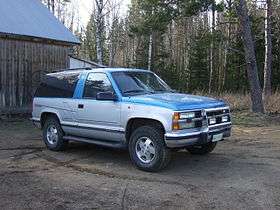 1992-1993 K1500 Blazer | |
| Overview | |
| Also called | GMC Yukon |
| Production | 1991–1994 |
| Model years | 1992–1994 |
| Assembly | Janesville Assembly Plant, Janesville, Wisconsin |
| Body and chassis | |
| Platform | GMT415 |
| Powertrain | |
| Engine | 350 cu in (5.7 L) L05 V8 379 cu in (6.2 L) Detroit Diesel V8 |
| Transmission | 4-speed 4L60 automatic 5-speed manual |
For 1992, GM redesigned its SUVs, moving to the GMT400 architecture that had debuted for the 1988 pickup lines. The GMC Jimmy was renamed Yukon. The standard engine remained the 350 cu in (5.7 L) small-block V8 with throttle-body fuel injection. A 6.5 L turbocharged Detroit Diesel V8 was added as an option for 1994, with output of 180 horsepower (134 kW) and 360 pound-feet (488 N⋅m) of torque. It was available only with a four-speed automatic transmission.[11]
The full-size Blazer was discontinued for 1995, replaced by the Chevrolet Tahoe which featured a two-door and four-door body style.
References
- "Directory Index: GM Trucks and Vans/1969_Trucks_and_Vans/1969_Chevrolet_Blazer_Brochure". Oldcarbrochures.com. Retrieved 2011-11-20.
- "Directory Index: GM Trucks and Vans/1971_Trucks-Vans/1971_Chevrolet_Blazer_Brochure". Oldcarbrochures.com. Retrieved 2011-11-20.
- "Directory Index: GM Trucks and Vans/1969_Trucks_and_Vans/1969_Chevrolet_Blazer_Convertible_Top". Oldcarbrochures.com. Retrieved 2011-11-20.
- "Directory Index: GM Trucks and Vans/1971_Trucks-Vans/1971_Chevrolet_Blazer_Brochure". Oldcarbrochures.com. Retrieved 2011-11-20.
- “2018 Chevrolet Tahoe and K5 Blazer Retro Mashup Will Make Your Brain Hurt” from The Drive (October 17, 2019)
- "Directory Index: GM Trucks and Vans/1973_Trucks_and_Vans/1973_Chevrolet_Blazer_Brochure". Oldcarbrochures.com. Retrieved 2011-11-20.
- "Directory Index: GM Trucks and Vans/1973_Trucks_and_Vans/1973_Chevrolet_Blazer_Brochure". Oldcarbrochures.com. Retrieved 2011-11-20.
- "Chevy Blazer specifications". ColoradoK5.com. Performance Media Group, Inc. Retrieved 2009-10-05.
- Blazer '76 catalog, Chevrolet Motor Division, September 1975, p. 4, archived from the original on 2011-07-08
- July 1976 FourWheeler magazine
- 1994 Suburban & Yukon, GMC Truck